SUNDAY JOINT, 4-23-2023: IF THE FLYING SAUCER'S ROCKIN' DON'T COME KNOCKIN'

Hey All,
The drink where you grab a little from every bottle in your parents' liquor cabinet and blast out into the night with your sticky 80-proof contraband feeling like Junior Johnson on a Carolina backroad outrunning a half-dozen G-Men? Like I said week before last, we called it a Suicide, my wife called it a Graveyard, and some of you out there called it Jungle Juice, or the Pearl Harbor, a Nutcracker, Rocket Fuel, the Flying Saucer.
Thanks, everyone, for all the replies, and here's mud in your eye. Let's pour another.
I get the feeling that Patti Paniccia, described recently by champion-of-champions Steph Gilmore as "so stylish, so poised and so cool," might confiscate our Flying Saucer. Or maybe not confiscate it, but she would for sure not hit it more than once or twice, then turn around and give us a lecture on responsible drinking. And she'd be right. Paniccia—pro surfer, world tour cofounder, CNN reporter, law professor, civil rights fighter—has no doubt made a mistake or two in her stylish and poised seven decades on earth, but she basically doesn't fuck up, not like the rest of us anyway, and her record of good decision making, of putting in more than she takes, is without equal. Patti's EOS page and interview both posted last week, and I get a moral contact high just writing about her.
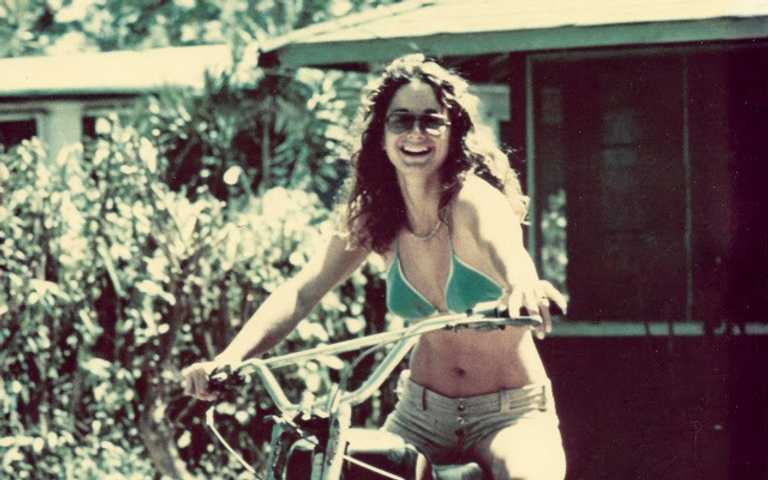
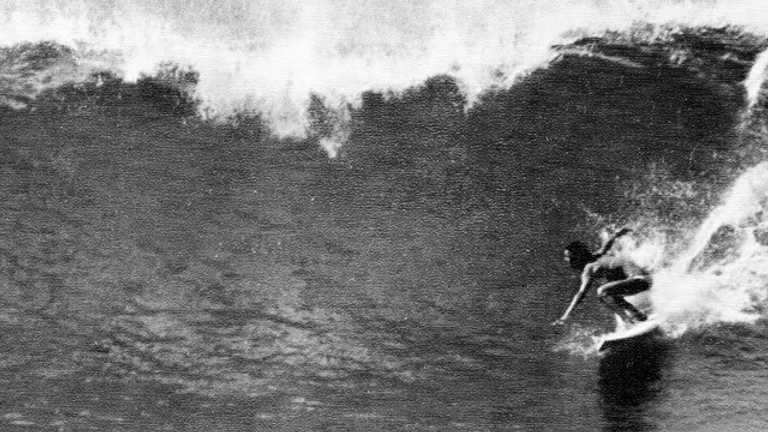
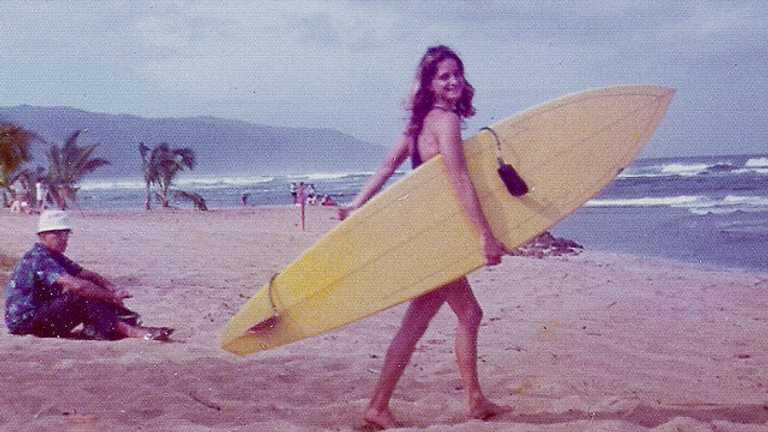
It wasn't very Paniccia-like of me to make fun of Fred Hemmings and his white short-sleeve button-down accountant's shirt, tucked into his trunks no less, as seen in The Professionals, and one of you out there called me out for unbecoming snarkiness. I do not repent. I am obligated, however, to apply the same yardstick to a surfer whose hatchet-nosed visage I would carve on Surfing Mount Rushmore, next to a huge granite flask, and that brings us to this 1969 Jack's Surfboards ad, below. The man on the left is of course Dale Velzy, ID'd and rightly so as a Master Shaper of surfboards. I believe Velzy made a sartorial error in borrowing Hemmings' shirt, and further biting Fred's style by tucking it into his Levis. I might argue that wearing cowboy boots on the beach at Huntington is a step toward mitigation, and maybe throws the whole look into the realm of irony.

But enough fashion. Shift your eyes over a few inches, because that stickerless white board propped on Bob Milfeld's hip is the real attraction here. Many of you know about the Geoff McCoy-design Lazor Zap surfboard, from the early '80s, known generically as the no-nose—a modified version of which Cheyne Horan used to defeat Tom Carroll in the 1984 Bells contest—and a few of you may even recall that Greg Noll produced a commercially-available reduced-forward-area board in 1969. But this experimental dagger by Velzy, called the "Needle Nose," almost certainly made in late 1968, is weirder than any of them. I can't figure out if it was meant to be taken seriously, or was just Velzy throwing something weird out there, as he often did, to catch our attention. "Dale designed the Needle Nose for the aggressive high-performer demanding speed and feather weight," the ad says. "Super-small slingshot turns, face loops, and 360-degree maneuvers are its specialty." Which means somebody at least paddled the board out and tried it, because "super-small slingshot turns" means twitchier than Inspector Dreyfus losing sanity by the inch while in the presence of Inspector Clouseau. Funny onscreen, awful in the water. Velzy's Needle Nose sank without a trace.
"Surf Beach" is a sweet government-funded "day in the life" look at Bondi in 1965, and 1970's "At the Beach" is the same thing, same place, except longer sideburns for the men and no more bathing caps for the women. Surfing is featured in both, but we get the sunny and crowded Bondi scene in its entirety, from city workers picking up the trash, to lifeguards and snack vendors, and of course all the beachgoers towel-claiming their place in the sand to chat, sunbathe, read, smoke, play chess, flirt, nap. Part of me—the vestigial hardcore surfer—clenches at how tightly packed the environment is. But I also appreciate the inclusion and togetherness; how high-functioning it all seems, how smoothly the gears move as thousands of people find their leisure in dozens of ways, everybody going home at the end of the day, surfers and clubbies, school kids and pensioners, tired and grateful for their time at the beach.
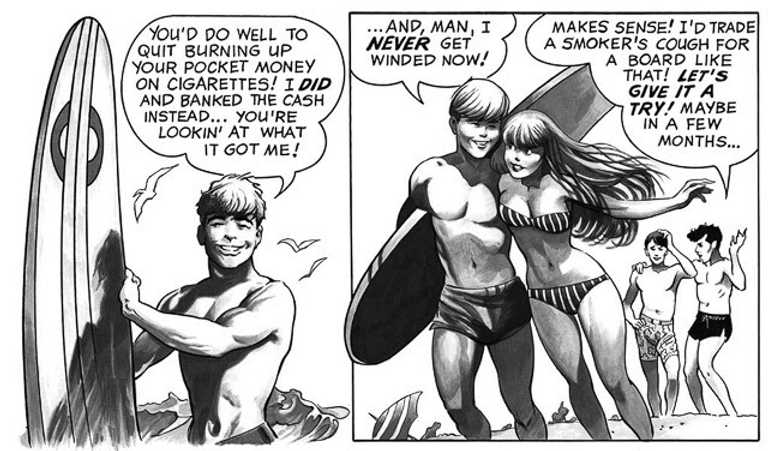
I got through this entire surf-themed anti-smoking PSA thinking it was a hoax or a put-on, but no, it is very real and was printed at least a half-dozen times, between 1964 and 1970, in comic-horror mags like Creepy and Eerie. The best part, for me, is not only does the cigarette-quitting surfer get a new board (see above left), but he's flexing on the fact that his newly smoke-free lungs have increased his stamina for après-surf tandem riding, if you know what I mean, wink-wink, #IneverGetWindedNow. The artwork here is by Frank Frazetta, the pompadoured chain-smoking New Yorker whose steroid-jacked axe-swinging barbarians and their mostly-undressed women made him the once and forever Michelangelo of fantasy art. While scrolling Frazetta's wild life and times online, I found out he also worked on Playboy's "Little Annie Fanny" cartoon strip, alongside Mad magazine's Harvey Kurtzman, and in fact contributed to the 1965 episode called "The Surfers" where topless Annie gets wiped out by a tidal wave and is saved by a glasses-wearing nerd named Ralphie, which leads to a twist ending where the surfers decide to gang up on a group of nearby snorkelers—because SUP hadn't been invented, I guess. Trigger warning: lots of giant cartoon boobies and casual Hugh Hefner-style misogyny in the full version of the strip, and I beg your forgiveness, Patti Paniccia, but Annie is a legit if very silly piece of surf history.
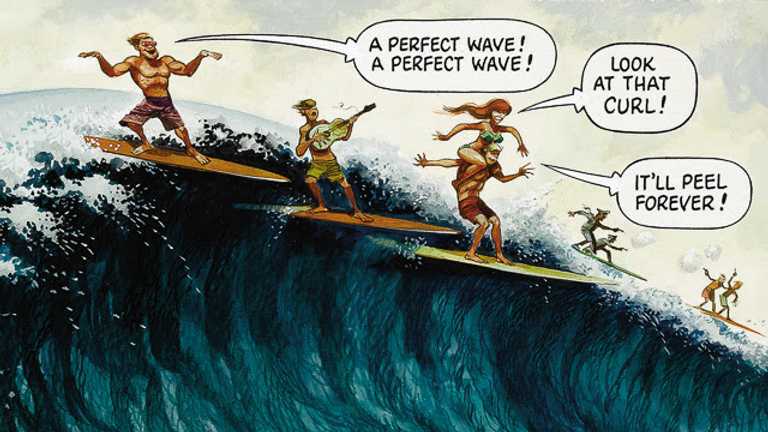
Thanks for reading, and see you next week!
Matt
PS: Frazetta's work is famously featured on LP covers by Florida boogie-metal band Molly Hatchet, but I just learned he also did the poster art for The Fastest Gun Alive, Roy Orbison's one and only acting role and certified box-office bomb, in which he plays a singing cowboy who guns down bad guys with a customized spring-loaded single-barrel guitar. What a strange movie this is! A musical-comedy-Western, and you feel like everybody involved knew it was dud from Day One but nobody wanted to be first to say it. Orbison's trademark Wayfarer sunglasses are nowhere to be seen, for starters, this being the 19th century and all, which is like shooting Clint Eastwood without his squint. Orbison also has to dance and grin and crack wise, and watching this clip is testimony to his innate good sense for quitting Hollywood after Fastest Gun, and a reminder that the reason we loved Orbison so much in the first place is that he did less-is-more better than anybody in rock history.
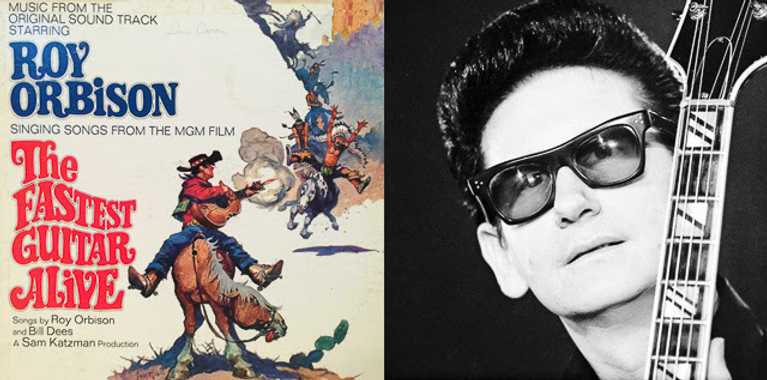
[Photo grid, clockwise from top left: Bondi surfers from the 1950s; Patti Paniccia at Ala Moana Rights; Junior Johnson not running moonshine; detail from Little Annie Fanny cartoon strip; flying saucer; Frank Frazetta. Patti Paniccia, 1973. Patti surfing Gas Chambers. Patti at Haleiwa Beach, 1980. Jack's Surfboards ad, 1969, photo by Brad Barrett. Detail from anti-smoking PSA by Frank Frazetta, text by Archie Goodwin. Detail from "The Surfers." Roy Orbison and LP cover from "Fastest Gun Alive." Big thanks to Peter Williams and Daved Marsh for info on Frank Frazetta]